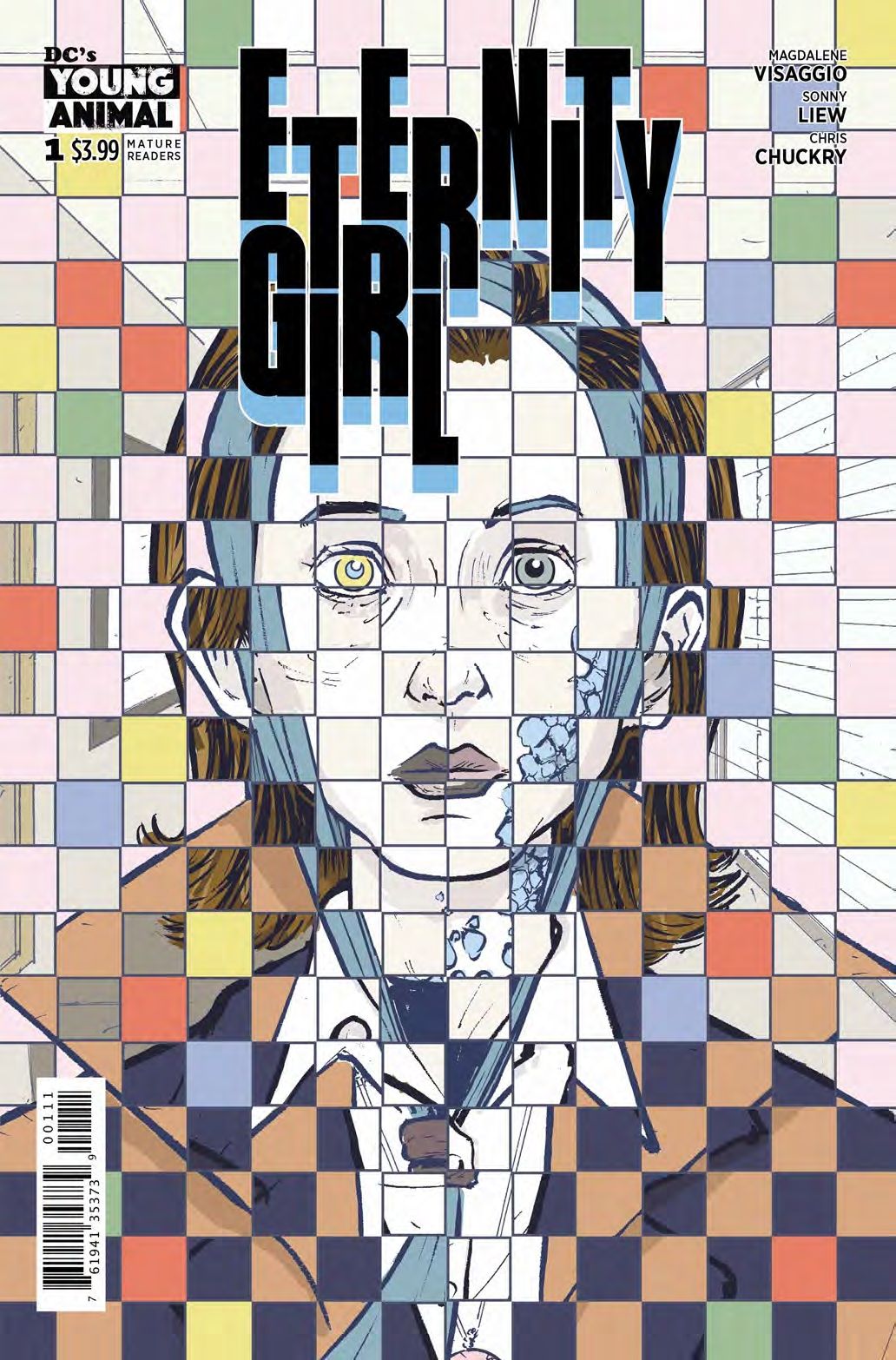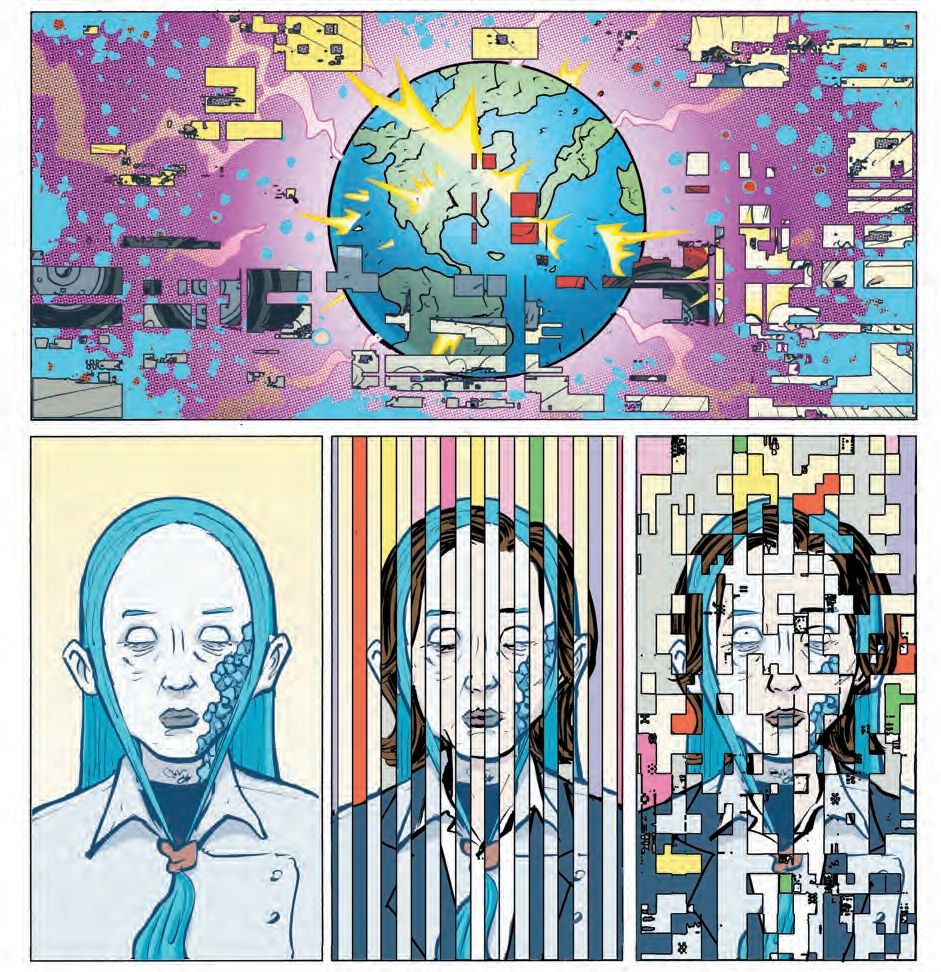Eternity Girl #1
- WRITER
- Magdalene Visaggio
- Artist
- Sonny Liew
- Letterer
- Todd Klein
- Cover Artist
- Sonny Liew
- Publisher
- DC Comics
- Price
- 3.99
- Release Date
- 2018-03-14
- Colorist
- Chris Chuckry
Endless Girl. You know Endless Girl, right? She’s a character created in 1956 by George Sumner, given shape-shifting powers by a magical Mesopotamian ziggurat, and reinvented multiple times over the years. A gritty, violent Watchmen-style deconstruction in the ‘80s team book Alpha 13, followed by the psychedelic reimagining of Chrysalis: The Eternity Girl in the early ‘90s, in line with the Vertigo books of the time.
Except, none of that really happened. The stories described above are doubly imaginary -- a made-up publishing history, laid out in the recent “Milk Wars” backup strips which were actually our first introduction to Eternity Girl. In the final strip, supposedly from 2008 and described in an attached editorial note as ‘experimental,’ she turns to the reader and tells you “this isn’t the page we’re supposed to be printing.” It’s unclear whether or not this is supposed to be part of the original fictional comic -- a spot of classic mid-'00s metafiction -- but by the end of DC/Young Animal crossover “Milk Wars," Eternity Girl seemingly escaped into the DC Universe.
RELATED: DC’s Eternity Girl Uses Superheroics to Explore Depression and Trauma
Which is where you might expect Eternity Girl #1 -- by the same creative team of Magdalene Visaggio and Sonny Liew -- to pick up. But you don’t need to have read any of “Milk Wars” to follow this story. Instead, the issue rolls back the high concept and starts with the basics, by introducing us to Eternity Girl -- aka Chrysalis, aka Caroline Sharp -- as a person.
Caroline was already trying to save the world, as part of government organization Alpha 13, when she got her superpowers, in the aforementioned ziggurat-related accident. But after those powers went haywire, Alpha 13 kicked her out. Now, feeling useless and distant from the world, Caroline desperately wants to die. Except, her powers won’t let her.
This is a heartbreaking way to meet a character, and one that makes it very easy to sympathzse with Caroline. We meet her best friend, Dani, when she turns up with cake and vodka after one of Caroline’s Alpha 13-mandated therapy sessions to check her friend is doing OK.
It’s a great, believable depiction of female friendship, something that’s all too rare in comics. Especially the kind of comics where one of the women involved is a shape-shifter, struggling to stay in a human form, until her friend tells her: “You don’t need to hold that shape for me.” That one line is a neat condensation of what friendship can be at its best.
Eternity Girl, it seems, is going to be a superhero story where all the superheroics are in the past, anchored in relatable, human characters. Except… well, there’s still the question of Eternity Girl’s fictional origins. Over the course of the issue, the storytelling slides into a more enigmatic mode.
We cut between different times, and possibly different realities, multiple times in a single page, seeing things that could equally be hallucinations or reality. Liew’s panel layout become looser and more experimental, at one point fragmenting in a style reminiscent of Frank Quitely. Caroline refers to an event from her own life as being "in the now-famous Alpha 13 #27."
Moments like these hint at how the metafictional aspects of Eternity Girl’s concept will play into this story, but they remain hints. We get just a couple of brief flashes back to these non-existent comics. This doesn’t give enough room for Liew’s remarkable ability to bend his own art style in a way that matches the historical context -- as shown in the backup strips and especially his award-winning graphic novel The Art of Charlie Chan Hock Chye -- to shine through. The heavy lifting is left to Chris Chuckry’s colors, which flatten the comic’s palette appropriately, with the traditional Ben-Day dots creeping in.
If you haven’t read the “Milk Wars” strips, you might not even notice this issue’s more metafictional tendencies. But read them together, and it’ll deepen your understanding of why Caroline is so eager to die. The character is trapped in an endless loop of reboots. She went through all the standard cycles of superhero comics -- gritty in the ‘80s, flowery in the ‘90s, meta in the ‘00s. Despite all that, she remains "Eternity Girl," even though Caroline is clearly a woman in her mid-30s. Or, taking her fictional publication history into account, her early 60s.
“At some point, characters should be allowed to rest,” Eternity Girl said in that last strip, apparently from 2008. It seems that Visaggio and Liew are going to give us a story about why comics publishers and readers can’t quite seem to let some characters die.


